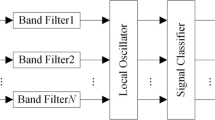Abstract
Signal representation in time-frequency (TF) domain is valuable in many applications including radar imaging and inverse synthetic aperture radar. TF representation allows us to identify signal components or features in a mixed time and frequency plane. There are several well-known tools, such as Wigner–Ville Distribution (WVD), short-time Fourier transform and various other variants for such a purpose. The main requirement for a TF representation tool is to give a high-resolution view of the signal such that the signal components or features are identifiable. A commonly used method is the reassignment process which reduces the cross-terms by artificially moving smoothed WVD values from their actual location to the center of the gravity for that region. In this article, we propose a novel reassignment method using the conditional generative adversarial network (CGAN). We train a CGAN to perform the reassignment process. Through examples, it is shown that the method generates high-resolution TF representations which are better than the current reassignment methods.





Similar content being viewed by others
Availability of data and materials
All of the material is owned by the authors and/or no permissions are required
References
Wehner, D.R.: High-Resolution Radar, 2nd edn. Artech House, Boston (1994)
Wang, Y., Ling, H., Chen, V.C.: ISAR motion compensation via adaptive joint time-frequency technique. IEEE Trans. Aerosp. Electron. Syst. 34(4), 670–677 (1998)
Thwe, K.Z., War, N.: Environmental sound classification based on time-frequency representation. In: 2017 18th IEEE/ACIS International Conference on Software Engineering, Artificial Intelligence, Networking and Parallel/Distributed Computing (SNPD), pp. 251–255 (2017). https://doi.org/10.1109/SNPD.2017.8022729
Chu, S., Narayanan, S., Kuo, C.-C.J.: Environmental sound recognition with time-frequency audio features. IEEE Trans. Audio Speech Lang. Process. 17(6), 1142–1158 (2009). https://doi.org/10.1109/TASL.2009.2017438
Mitra, V., Franco, H.: Time-frequency convolutional networks for robust speech recognition. In: 2015 IEEE Workshop on Automatic Speech Recognition and Understanding (ASRU), pp. 317–323 (2015). https://doi.org/10.1109/ASRU.2015.7404811
Claasen, T.A.C.M., Mecklenbraiuker, W.F.G.: The Wigner distribution—a tool for time-frequency signal analysis; part III: relations with other time-frequency signal transformations. Philips J. Res. 35(6), 372–389 (1980)
Hlawatsch, F., Boudreaux-Bartels, G.F.: Linear and quadratic time-frequency signal representations. IEEE Signal Process. Mag. 9(2), 21–67 (1992)
Flandrin, P., Auger, F., Chassande-Mottin, E.: Time-frequency reassignment: from principles to algorithms. In: Papandreou-Suppappola, A. (ed.) Applications in Time-Frequency Signal Processing, Ch. 5, pp. 179–203. CRC Press, Boca Raton (2003)
Goodfellow, I.J., Pouget-Abadie, J., Mirza, M., Xu, B., Warde-Farley, D., Ozair, S., Courville, A., Bengio, Y.: Generative adversarial networks (2014). https://doi.org/10.48550/ARXIV.1406.2661
Isola, P., Zhu, J.-Y., Zhou, T., Efros, A.A.: Image-to-image translation with conditional adversarial networks (2016). https://doi.org/10. 48550/ARXIV.1611.07004
Cohen, L.: Time-frequency distributions—a review. Proc. IEEE 77(7), 941–981 (1989)
Jones, D.L., Baraniuk, R.G.: An adaptive optimal-kernel time-frequency representation. IEEE Trans. Signal Process. 43(10), 2361–2371 (1995)
Deprem, Z., Çetin, A.E.: Crossterm-free time-frequency distribution reconstruction via lifted projections. IEEE Trans. Aerosp. Electron. Syst. 51(1), 1–13 (2015)
Deprem, Z., Çetin, A.E.: Kernel estimation for time-frequency distribution. In: 2015 23nd Signal Processing and Communications Applications Conference (SIU), pp. 1973–1976 (2015). https://doi.org/10.1109/SIU.2015.7130250
Lecun, Y., Bottou, L., Bengio, Y., Haffner, P.: Gradient-based learning applied to document recognition. Proc. IEEE 86(11), 2278–2324 (1998). https://doi.org/10.1109/5.726791
Buades, A., Coll, B., Morel, J.-M.: A non-local algorithm for image denoising. In: 2005 IEEE Computer Society Conference on Computer Vision and Pattern Recognition (CVPR’05), vol. 2, pp. 60–652 (2005). https://doi.org/10.1109/CVPR.2005.38
Eigen, D., Fergus, R.: Predicting depth, surface normals and semantic labels with a common multi-scale convolutional architecture (2014). https://doi.org/10.48550/ARXIV.1411.4734
Radford, A., Metz, L., Chintala, S.: Unsupervised representation learning with deep convolutional generative adversarial networks. Comment: Under Review as a Conference Paper at ICLR 2016 (2015). arXiv:1511.06434
Zhang, R., Isola, P., Efros, A.A.: Colorful image colorization (2016). https://doi.org/10.48550/ARXIV.1603.08511
Mathieu, M., Couprie, C., LeCun, Y.: Deep multi-scale video prediction beyond mean square error. In: 4th International Conference on Learning Representations, ICLR 2016; Conference Date: 02-05-2016 Through 04-05-2016 (2016)
Wang, X., Gupta, A.: Generative image modeling using style and structure adversarial networks (2016). https://doi.org/10.48550/ARXIV.1603.05631
Mirza, M., Osindero, S.: Conditional generative adversarial nets (2014). https://doi.org/10.48550/ARXIV.1411.1784
Ronneberger, O., Fischer, P., Brox, T.: U-Net: Convolutional networks for biomedical image segmentation (2015). https://doi.org/10.48550/ARXIV.1505.04597
Auger, F., Flandrin, P., Gonçalves, P., Lemoine, O.: Time-frequency toolbox for use with MATLAB (1996). http://tftb.nongnu.org
Abadi, M., Barham, P., Chen, J., Chen, Z., Davis, A., Dean, J., Devin, M., Ghemawat, S., Irving, G., Isard, M., Kudlur, M., Levenberg, J., Monga, R., Moore, S., Murray, D.G., Steiner, B., Tucker, P., Vasudevan, V., Warden, P., Wicke, M., Yu, Y., Zheng, X.: Tensorflow: a system for large-scale machine learning. In: 12th USENIX Symposium on Operating Systems Design and Implementation (OSDI 16), pp. 265–283 (2016). https://www.usenix.org/system/files/conference/osdi16/osdi16-abadi.pdf
Pearson, K.: Notes on regression and inheritance in the case of two parents. Proc. R. Soc. Lond. 58, 240–242 (1895)
Baraniuk, R.G., Flandrin, P., Janssen, A.J.E.M., Michel, O.: Measuring time-frequency information content using the Rényi entropies. IEEE Trans. Inf. Theory 47(4), 1391–1409 (2001)
Acknowledgements
Not applicable
Funding
The authors have no funding for this work.
Author information
Authors and Affiliations
Contributions
ZD wrote the main manuscript. All the authors reviewed the manuscript.
Corresponding author
Ethics declarations
Conflict of interest
The authors have no competing interests as defined by Springer, or other interests that might be perceived to influence the results and/or discussion reported in this paper.
Consent to participate
The authors accept the ethical responsibilities and have the consent to participate.
Consent for publication
Not applicable.
Ethics approval
The results/data/figures in this manuscript have not been published elsewhere, nor are they under consideration by another publisher.
Additional information
Publisher's Note
Springer Nature remains neutral with regard to jurisdictional claims in published maps and institutional affiliations.
Rights and permissions
About this article
Cite this article
Deprem, Z., Çetin, A.E. High-resolution time-frequency representation with generative adversarial networks. SIViP 17, 849–854 (2023). https://doi.org/10.1007/s11760-022-02297-x
Received:
Revised:
Accepted:
Published:
Issue Date:
DOI: https://doi.org/10.1007/s11760-022-02297-x




